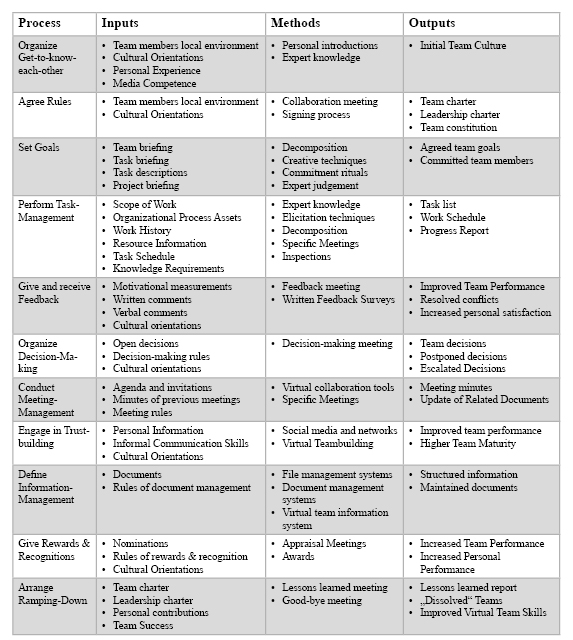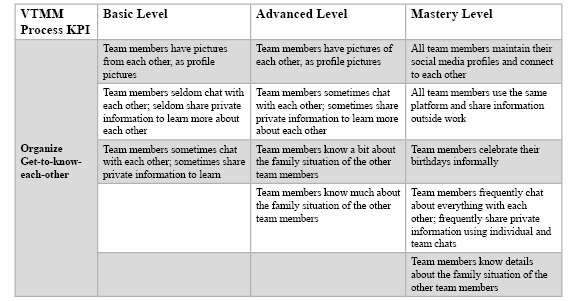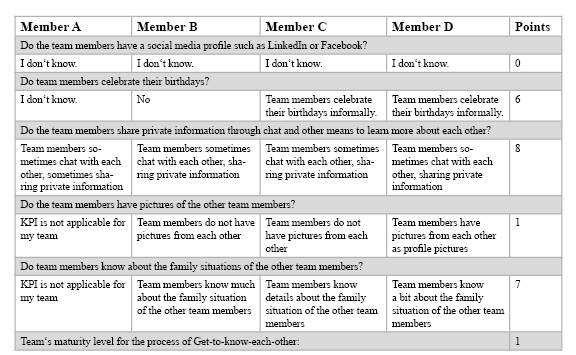Verbesserung der Performance von virtuellen Teams mithilfe von VTMM – eine praktische Fallstudie
DOI Nr.: https://doi.org/10.25929/kvvx-1p10
Ralf Friedrich
CIT - Cork Institute of Technology
Hochschule Darmstadt
Udo Bleimann
Hochschule Darmstadt
Ingo Stengel
Hochschule Karlsruhe
Paul Walsh
CIT - Cork Institute of Technology
ABSTRACT
The Virtual Team Maturity Model (VTMM) describes 11 processes for the performance improvement of virtual teams. Many organizations work in virtual team structures without having an understanding of their current team performance, while other organisations start virtual teamwork without any prior experiences, thus suffering a drop in performance. VTMM is designed to provide guidance to internal team performance improvement initiatives and to allow customers to assess the virtual team performance of their partners and suppliers. This paper describes a real-world case study on performance improvement for a virtual team within a large international consultancy company headquartered in Germany. The paper describes the methodology and process steps applied during the assessment and re-assessment of the team. Results describe findings relevant to virtual team process improvement in real-world settings.
Das Virtual Team Maturity Modell (VTMM) beschreibt 11 Prozesse zur Leistungssteigerung virtueller Teams. Viele Organisationen arbeiten in virtuellen Teamstrukturen, ohne wirklich zu verstehen, welche Prozesse dabei wichtig sind. Sie erleben einen Leistungsabfall, weil sie keine Erfahrungen in diesem Bereich haben. VTMM erlaubt virtuellen Teams, eine Reifegradmessung vorzunehmen. Außerdem können Partner und Lieferanten im Hinblick auf ihre virtuellen Teamprozesse bewertet werden. Dieser Artikel beschreibt eine Fallstudie einer Leistungssteigerung eines virtuellen Teams einer Unternehmensberatung mit Hauptsitz in Deutschland. Der Artikel beschreibt die Methode des Vorgehens beim Erst- und Wiederholungs-Assessment des Teams. Die Ergebnisse sind beschrieben. Die wichtigsten Erkenntnisse für virtuelle Teamarbeit werden hervorgehoben.
KEYWORDS
VTMM, virtual teamwork, performance improvements, maturity model, virtual team processes
Introduction
Virtual teams are a common organization structure in the world of enterprise in the 21st century, as more and more organizations cope with the increasing demands of globalization, outsourcing, off-shoring and telework. A popular type of virtual team is a project-based group, which is distributed geographically and is mainly focused on meeting milestones for stakeholders and has the added ability to make decisions [1]. For example, many organizations employ an outsourcing model where some team members are located in developed economies, while other team members work from locations in low cost countries [2].
In this paper, the case study subject team was operating in different locations. This team is therefore virtualized corresponding to the definitions and models provided by Guzmán et al. [3], Chudoba et al. [4], Ivanov and Cyr [5], Müthel and Högl [6], Leonard [7] and Lockwood [8].
The Advantages of Virtual Teamwork
A notable benefit of virtual teamwork is enhanced productivity, which “tends to increase from 10% to 43%, depending on the industry and the organization” [9]. This stems from efficiencies such as reduced travel time and other overhead activities. Other studies similarly note that virtual teams reduce time-to-market, save money on travel expenses, offer more flexibility to employers and employees, attracting highly qualified employees from all over the world, while increasing knowledge sharing [8].
Challenges within Virtual Teamwork
However, despite the rise of interest in virtual teams, there are considerable challenges that need to be addressed. Early researchers note that virtual teamwork practices require different competencies and skills from team members [10-12].
Nemiro et al. [13] observed that a virtual team has to overcome the following external and internal challenges:
1. External factors (virtual teams) are those factors that are outside the control of a virtual team, which has to find a way to manage them, in particular distance, time and technology.
2. Internal factors (virtual team creations) are those within the control of a virtual team, where the team can directly influence these factors, specifically culture, trust and leadership.
Nemiro defines external factors as constraints that cannot be changed by the team, which has to learn how to deal with them. Unfortunately, technology can also have limitations. Many internal IT-organizations do not implement state-of-the-art communication technologies that would make virtual teamwork more efficient. Moreover, even the latest state of the art technologies carry the risks of miscommunications [14].
The internal factors are under the direct influence of the virtual team. One of the key success factor for teamwork is to have clear communication protocols to compensate for absent non-verbal communication. A good virtual communication can lead to trust in the team, which is considered another success factor. The relationship of missing non-verbal communication and trust are discussed by Pangil and Chan [15]. Missing non-verbal communication reduces trust. Another aspect to focus on is the development of a team culture. Problems in inter-cultural collaboration are described by Andersen [16]. If the team has a good cohesion and collaboration, then the leadership aspects are less important, as described by Saafein and Shaykhian [17], as the leadership will be shared amongst the team members.
Based on this ground research, VTMM was developed to first identify and then improve limitations in virtual teams so that trust, culture and shared leadership can be fostered.
The Virtual Team Maturity Model VTMM
The aim of the virtual team maturity model (VTMM) is to gauge the level of virtual teamwork competence in project teams. The model focuses on the internal project team processes which are necessary to compensate for critical factors such as the lack of face-to-face interactions, challenges in imparting tacit communication, building trust, giving feedback, establishing work rules and offering rewards and recognition. The VTMM model aims to define a meta-process, which helps to create a highly motivated virtual project team, leading to trust, cohesion and consequently leading to an improved team performance and better project results. The VTMM serves as a reference model against which virtual teams can be assessed and whereby gaps in the performance can be identified and closed [18].
The model was validated by an expert panel of over 80 members, which was convened by following rigorous selection criteria where job title and qualification was considered1. Statistical analysis of the feedback from the panel validated the assumptions of the model and showed that the VTMM adds true value to virtual project teams.
The model is composed of 11 virtual team processes and four maturity levels. Each process is described by inputs, methods and outputs. These are measured by key performance indicators (KPIs), which gauge how well a process is present in a virtual team. Four maturity levels were chosen, as they are a good balance between good differentiators of virtual team maturity and practical application.
So far, no academically validated maturity model for virtual teams has been found in literature. Only isolated processes and their effects on virtual teamwork have been researched academically [19-21]. Comprehensive maturity models have been developed and applied, but their effects have not been tested systematically [22, 23]. The structure of staged maturity models and definitions of maturity levels originate from the models of EFQM and CMMi [23, 24]. VTMM development was also influenced by the work of Jehle and Zofi [22, 25]. In the VTMM, there are four maturity levels: undefined, basic, advanced and mastery level [18]. Four levels is a good compromise between practical application and differentiation of maturity:
- At the undefined level, there are many gaps compared to the reference model. The success of the team cannot be traced back to the conformance to virtual team processes. Many of the processes, tools or cultural elements are missing and most likely also unknown to the virtual team members, leaders and sponsors. Virtual teams at this level can be successful, but rely on individual strengths and charisma of the leader and/or its team members. Therefore, the virtual team does not know what to do to improve the performance of the virtual team.
- At the basic level, the team is aware of the requirements to increase the performance of the virtual team. All the quick wins have been implemented. The team performance and productivity increased, the level of conflict decreased and the team members have developed trust and deepened their relationships.
- At the advanced level, all elements of the VTMM are present: the virtual team has a positive culture, the different tools are used appropriately for different tasks and either the virtual team processes are fully implemented or the decisions not to implement them have been well documented. The level of conflict is low and the performance is high. The team invests time into relationships with other team members. Complex tasks are managed successfully and issues are tabled early and dealt with efficiently.
- At the mastery level, all elements are present to the needed levels. The team is in a state of ”flow“ and the performance is very high. The team has implemented knowledge management processes and works on the optimization of processes, tools and culture. Team members enjoy being on the team and the project progresses according to schedule, budget and scope, including the right quality. The team performance will maintain this level of performance even if there are changes in the team (members leaving or entering the team).
1Over 90% of panel members hold a PMP certification. PMP is a trademark of the PMI – Project Management Institute,
Pennsylvania, USA
The definition of the processes is described in terms of:
- inputs - providing necessary information of the state and nature of the team,
- tools and techniques - applied to improve the processing of this information and formation of the process and
- outputs - expected to benefit the performance of a virtual team.
The selection of the 11 processes of VTMM and the definition of each process’s inputs, methods and outputs incorporates Tuckman’s theory on group development processes, which was supported throughout the last decade by various research studies and practical investigation on team development [13, 25-29]. It also integrates the holistic approach on group processes by Cohn [30] and Hornecker [31].
Cohn described in her Theme Centered Interaction (TCI) theory that the relationship between the individual and the team needs to be established. To achieve this, Cohn formulated three axioms:
1. The human being is a psychobiological unity and a part of the universe. For the reason he is autonomous and interdependent at the same time. An individual’s sense of autonomy becomes more and more refined when his consciousness of everyone’s interdependence expands. This is an anthropological axiom.
2. Reverence is due to everything living, and to its growth. Respect for growth necessitates value judgments in decisions. The humane is valuable, the inhumane is threatening to values. This is an ethical axiom.
3. Free will occurs within conditional internal and outer boundaries. Expansion of these boundaries is possible.
Based on these three axioms, Cohn defined two postulates:
1. Be your own Chair person
2. Disturbances and strong involvements have precedence.
The observation made in field research and during consulting engagements with virtual teams showed that virtual teams focus mainly on the task and ignore the needs of the team members. VTMM addresses these needs in form of processes. The first process a virtual team should follow is the “Organize Get-to-know-each-other” process. This process will provide the team members with some basic knowledge about each other and will start building the relationship between team members.
This also links to Tuckman’s team phase theory. Tuckman’s theory identified five stages of team development. The VTMM processes can be mapped directly to these stages as shown in Table 1 below:

Table 1: Tuckman´s Team Development Stage vs. VTMM Process
This shows that VTMM transforms the theories of Tuckman and Cohn from a traditional face-to-face team environment into a virtual team environment.
One of the contributions of the VTMM is the tailored approach to maturity, as each team is different and has its own needs on maturity. In some processes, a high maturity level is required, in other processes a lower one. Therefore, in the beginning of the maturity improvement journey, the team decides the target levels. Maturity development has to be driven by economical motivation. In reality, the implicit goal of perfection is fundamentally difficult to achieve as the team has to deliver the project in the most efficient way.
VTMM – Virtual Team Maturity Model
The 11 processes of VTMM are described in Table 2. The description of all processes in detail can be found on http://www.vtmm.org.

Table 2: VTMM processes and their Inputs, Methods and Outputs
The 11 processes have been described seperately by several authors [12, 32-35] in various contexts. The processes have been included in the model based on validated relevance for team performance by the expert panel. This first ongoing field study has provided strong positive feedback.
The VTMM Key Performance Indicators
Each VTMM process is defined through KPIs, which have a different quality for each of the levels. The “Organize Get-to-know-each-other”-process is shown as an example in Table 3:

Table 3: The VTMM KPI´s of the “Organize Get-to-know-each-other”-process
On the Basic level, there is just little information available about other team members. Team members have limited interactions with each other. On the Advanced level, the team members share more information about each other and engage in personal information. At the Mastery level, the team members engage in deep social interactions, because they care about the team members, not because they have to. This shows an evolution of the interactions between the team members and this interaction can be assessed.
This example also shows the principle of VTMM KPIs. They are not simple yes/no measurements but capture social interactions and the way the virtual team engages with all team members. So the KPIs capture the perception of how much the processes are consistently present within the team.
The result of an assessment can be a uniform opinion about the team’s performance in this process or a diverse opinion about the team’s performance on this process. The latter case is more common after an initial assessment. This indicates that sub-teams have different perceptions about the team’s performance. An usual improvement is to align all team members on a common team maturity level.
A traditional face-to-face team compensates for the get-to-know-each-?other? process through non-verbal communications (team member look at each other in the meeting room, having casual conversations at the coffee machine, etc.). Virtual teams need a process to compensate the missing non-verbal communication. The impact on non-verbal communication was researched by Hinde [36]. The human brain did not develop significantly since then, however technology made a huge leap. Now, we need to learn how to communicate with the available technology. This is the spirit of VTMM KPIs.
The VTMM assessment process
VTMM was evaluated in a real world scenario in a longitudinal study on an active industry team with firm deadlines, deliverables and milestones, where VTMM assessments are based on Deming’s Plan-Do-Check-Act (PDCA)-cycle [37]. There are two different approaches to a VTMM-assessment. One approach supports an internally driven virtual team improvement process and the other supports assessment of supplier team capability.
The VTMM-assessment process for an internal improvement initiative is outlined below:
1. The team does the full VTMM assessment where all VTMM processes are assessed.
2. The results are presented to the team leader and a report is generated.
3. The VTMM model is tailored to the requirements of the team, as some processes may be irrelevant to that particular team. Up to three processes can be tailored for the follow-up assessments.
4. Up to three improvement initiatives will be agreed on with the team leader and a schedule for the follow-up assessment will be planned.
5. After the agreed time, a re-assessment will take place and the results will be shown. Then the next round of improvement will repeat until the team reaches the required team performance.
VTMM is less prescriptive for internal team performance improvement initiatives. The value for the team is the focus of the assessment and the processes should be optimized to get the fastest and most cost effective improvement for the team.
The VTMM assessment for a client-supplier assessment is implemented as follows:
1. VTMM is tailored to the needs of the client before the first assessment takes place. The client can tailor the levels and the processes of VTMM according to the requirements. It is recommended to have all processes included in the assessment.
2. The supplier is assessed and the results are presented to the client and the supplier.
3. An improvement plan is agreed including improvement activities and deadlines.
4. A follow-up assessment is performed according to the schedule published in the improvement plan.
5. If necessary, further improvement activities are needed.
In this type of assessment, VTMM is used as a benchmark for the client getting the right level of confidence in the team performance of its suppliers and partners. As VTMM is designed in a flexible way, in terms of level definition and processes, the model can be tailored to the needs of the organization. The objective is to get a standard implemented. VTMM in its standard version should cover 80% of the requirements for good virtual communication processes for any team.
Calculation of the maturity level
The KPI’s of each level of the process have a point value according to the maturity level:
- Undefined: 0 Point
- Basic: 1 Point
- Advance: 2 Points
- Mastery: 3 Points
Then each team member rates the presence of a process according to the KPI. The level is calculated by the sum of the assessment for each process divided by the number of team members. A full number needs to be achieved for the level, e.g. 1.8 is still level 1 and not level 2. During this assessment, differences in perception become visible, too. If one sub-team gives high scores and the other sub-team for the same process low scores, then there is a difference in perception, which needs addressing by the team leader.
Cost of VTMM performance improvement efforts
In the current business environment, the available budgets for internal improvement activities are low. A maturity assessment of any kind needs to be cost-conscious. VTMM was designed to reduce the efforts and durations of an assessment and to allow for fast iterations in team performance improvements. This approach was taken from the agile software development life cycle [38].
Completing an assessment questionnaire takes about 15 minutes per team member. The presentation of the results and the development of an action plan takes about 2 hours for the team leader. The implementation of the action plan is time-boxed for about 4 weeks with an effort of about 1 - 2 hours/week for each team member. The action plan normally has three improvement activities, which the team leader will facilitate with the team. It is recommended to have two to three virtual meetings for the implementation of one improvement activity. Practical observation with real virtual teams showed that more than three improvement activities is too much change for the team. Finally, the team is re-assessed and the results are presented. The efforts and durations are identical as that of the steps of the initial assessment. The total effort requires a low investment from the team compared to the potential increase of team performance.
The international consultancy company case study
The case study company has a typical business unit structure. As a result of many years of project experience, the company also offers their own software products and solutions.
Since the founding of the company in the early 1980s, it has been consulting with customers on how to optimize their business processes and systems. The consultancy focuses predominantly on the banking and insurance sectors, on telecommunication, information, tourism, logistics and media. Their staff combines IT with domain expertise and are held accountable to high professional standards when it comes to consulting and executing complex IT projects. The company’s research & development team reviews and analyses trends, evaluates technologies and assesses them within the context of scientific studies.
The company is headquartered in Germany with offices around the world and around 700 staff work in distributed teams for the company in numerous international projects.
Within this company, one team was selected for the longitudinal case study while working virtually on real-world projects.
Research Methodology for the Case Study
The case study was designed according to Deming’s PDCA (Plan – Do – Check – Act) cycle of continuous improvement. First the self-assessment was planned and agreed with the team leader. Then four team members including the team leader completed the full VTMM assessment. After the results were presented, the team leader decided to extend the assessment to the whole team. Moreover, an improvement plan was agreed on and implemented by the team leader. After the agreed schedule, a re-assessment was carried-out checking the performance improvement made by the team.
The results of the initial assessment are shown in Table 4 below. The Undefined level answers are shown in normal print, the Basic level answers are shown in italics, the Advance level answers are shown in bold and the Mastery level answers are shown in bold and italics:

Table 4: Results of the initial assessment
In total, the team achieved 23 points from 60 possible points n?=?20 replies. Dividing the points through the number of replies results in 1,15 which corresponds to level 1: Basic of VTMM. In addition, this assessment showed a significant difference between Member A and Member D. This is an indication that the perception on the team’s performance about this process is very different. As the team member’s age was on average around 40 years, it is not surprising that the team did not use social media too much for their team interactions.
The eight team members were in age and gender:
- 1 x 18-35, male
- 1 x 18-35, female
- 3 x 36-50, female
- 2 x 36-50, male
- 1 x >50, male
The team leader tailored the VTMM processes “Engage in Trust-Building” and “Arrange Ramping-Down” after the initial assessment, as the team members have been working together for several years and there is no change planned. These two processes were not classified as relevant contributing factors for the team performance. Therefore, the team wanted to focus on other processes for the improvement initiative. This was a valid approach for this internal self-assessment based on the steady environment that the team operates in. There is no fluctuation in the team. The team works together for some time and there is a good level of trust within the team.
The team leader agreed on presenting the results to the team and discussing the possible improvements. This discussion alone proved valuable to the team’s performance as the different perceptions could be aligned. After three months a re-assessment was done showing improvements in team performance.
Results and Improvements
Figure 1 shows the results of the initial assessment:

Figure 1: Results of the Initial Assessment
This team had good results on the VTMM processes “Organize Decision-Management”, “Perform Task Management” and “Define Information Management”. The process “Give and receive Feedback”, “Give Rewards & Recognitions” and “Engage in Trust building” were less present on the team. Also within the processes of “Agree Rules” and “Set Goals” there was a strong diverse view on its presence within the team.
After three months, a reassessment was carried-out. The results were as shown in Figure 2.

Figure 2: Results of the re-assessment
As shown in Figure 2, the team performance improved in many areas. Still there is a need for improving the “Give Rewards & Recognition” process. In addition, the results were more aligned and the variation within a process significantly reduced. The team discussed the processes and what is needed for good team performance. This created a common awareness among the team members.
This shows that the team performance increased through the application of VTMM.
This pilot longitudinal VTMM assessment is inline with the findings from the Delphi experiment, showing the importance of VTMM processes compared to its practical implementation as shown in Figure 3 below:

Figure 3: Importance and presence of the 11 processes of VTMM, from the Delphi expert panel
Figure 3 shows that “Give Rewards & Recognitions” was in general also poorly present on virtual teams. In general, the softer processes (Give and receive Feedback, Engage in Trust building) are less present in virtual teams. This indicates that the relationship between the individual and the team needs to be improved so that the overall team performance can be improved. The results correspond with the findings of Cohn in her TCI-model.
Conclusions
Virtual teams play a key role in business productivity, as more and more activity is dispersed across geographically distributed teams. Having even a minor impact on the performance of a virtual team should have a major impact on productivity. The VTMM tool sets about to enhance the efficiency of virtual teams by assessing and improving performance across 11 different dimensions. The objective of this pilot case study was to therefore to validate the VTMM assessment processes within a real virtual team. The results showed a positive trend and that the assessment principles of VTMM and the KPIs are applicable to industry-based virtual teams. In addition, the industry team leader, who was initially sceptical about the value of VTMM expressed surprise that a team, that had worked together well in the past, found so many improvements in team performance. On foot of this, the VTMM was then extended to the full team.
References
[1] D. L. Duarte and N. Tennant Snyder, Mastering virtual teams: Strategies, tools, and techniques that succeed, 3rd ed. San Francisco, CA: Jossey-Bass, 2006.
[2] T. Philip, E. Wende, and G. Schwabe, “Exploring Early Warning Signs Of Failure In Offshore-Outsourced Software Development Projects At The Team Level: Paper 196,” in European Conference on Information Systems (ECIS) 2013 Completed Research: ECIS 2013 Proceedings, Association for Information Systems Electronic Library (AISeL), Ed, 2013.
[3] J. G. Guzmán, J. Saldaña Ramos, A. Amescua Seco, and A. Sanz Esteban, “Success Factors for the Management of Global Virtual Teams for Software Development,” in Enhancing the modern organization through information technology professionals: Research, studies, and techniques, R. Colomo-Palacios, Ed, Hershey, Pa: IGI Global (701 E. Chocolate Avenue, Hershey, Pennsylvania, 17033, USA), 2013, pp. 239–249.
[4] K. M. Chudoba, E. Wynn, M. Lu, and M. B. Watson-Manheim, “How virtual are we? Measuring virtuality and understanding its impact in a global organization,” Information Systems Journal, vol. 15, no. 4, pp. 279–306, 2005.
[5] Ivanov, A. and Cyr, D. (2014). Satisfaction with Outcome and Process from Web-based Meetings for Idea Generation and Selection: The Roles of Instrumentality, Enjoyment, and Interface Design. Telematics and Informatics, 31, 543-558.
[6] M. Müthel and M. Högl, “Tackling the Leadership Challenge in Dispersed Project Teams,” Projekt Management aktuell, no. 5, pp. 32–39, 2008.
[7] B. Leonard, “Managing Virtual Teams,” HR Magazine, no. June, pp. 39–42, 2011.
[8] N. R. Lockwood, “Successfully Transitioning to a Virtual Organization: Challenges, Impact and Technology,” SHRM Research Quarterly, no. First Quarter, pp. 2–10, http://www.global-dynamics.com/uploads/images/2010%201st%20quarter%20SHRM%20%20Research%20Quarterly%20-%20Successfully%20Transitioning%20to%20a%20Virtual%20Organization%20-%20Challenges,%20Impact%20and%20Technology.pdf, 2010.
[9] M. Dorr, Developing Real Skills for Virtual Teams. Available: http://www.kenan-flagler.unc.edu/executive-development/custom-programs/~/media/Files/documents/executive-development/developing-real-skills.ashx.
[10] S.-S. Wong and R. M. Burton, “Virtual Teams: What Are Their Characteristics, and Impact on Team Performance?,” Computational & Mathematical Organization Theory, vol. 6, no. 4, pp. 339–360, 2000.
[11] W. Curlee, “Modern virtual projectmanagement: The effects of a centralized and decentralized project management office,” Project Management Journal, vol. 39, no. S1, pp. 83–96, 2008.
[12] K. Cormican, S. Morley, and P. Folan, “An Analysis of Virtual Team Characteristics: A Model for Virtual Project Managers,” Journal of Technology Management & Innovation, vol. 10, no. 1, pp. 188–203, 2015.
[13] J. E. Nemiro, The handbook of high-performance virtual teams: A toolkit for collaborating across boundaries, 1st ed. San Francisco: Jossey-Bass, 2008.
[14] M. E. Fitzpatrick, “Cultural Discourse Practices 2.0: A Thesis Presented to the Faculty of California State University, Chico,” California State University, Chico, CA, USA, 2014.
[15] F. Pangil and J. M. Chan, “The mediating effect of knowledge sharing on the relationship between trust and virtual team effectiveness,” Journal of Knowledge Management, vol. 18, no. 1, pp. 92–106, 2014.
[16] E. Andersen, Why Purely Virtual Teams Don‘t Work. Available: http://www.forbes.com/sites/erikaandersen/2013/04/01/why-purely-virtual-teams-dont-work/.
[17] O. Saafein and G. A. Shaykhian, “Factors affecting virtual team performance in telecommunication support environment,” Telematics and Informatics, vol. 31, no. 3, pp. 459–462, 2014.
[18] R. Friedrich, U. Bleimann, I. Stengel, and P. Walsh, “VTMM - Virtual Team Maturity Model,” in Proceedings of the 7th European Conference on Management, Leadership and Governance: SKEMA Business School, Sophia-Antipolis, France, 6-7 October 2011, C. Despres, Ed, Reading: Academic Publishing, 2011, pp. 159–166.
[19] S. M. Bryant, S. M. Albring, and U. Murthy, “The effects of reward structure, media richness and gender on virtual teams,” International Journal of Accounting Information Systems, vol. 10, no. December, pp. 190–213, 2009.
[20] T. U. Daim, A. Ha, S. Reutiman, B. Hughes, U. Pathak, W. Bynum, and A. Bhatla, “Exploring the communication breakdown in global virtual teams,” International Journal of Project Management, vol. 30, no. 2, pp. 199–212, 2012.
[21] P. Kanawattanachai and Y. Yoo, “The Impact of Knowledge Coordination on Virtual Team Performance Over Time,” MIS Quarterly, vol. 31, no. 4, pp. 783–808, 2007.
[22] L. Jehle and M. Ribeiro, “Globale virtuelle Projektteams und kulturelle Zusammenarbeit,” in vol. 2, Neuigkeiten vom PMI in Süddeutschland, PMI Muc Live, Ed, 2015, pp. 15–19.
[23] European Foundation for Quality Management (EFQM), EFQM Excellence Model 2013: Kindle Edition, 2013.
[24] M. B. Chrissis, M. Konrad, and S.Shrum, CMMI: Guidelines for process integration and product improvement. Boston: Addison-Wesley, 2003.
[25] Y. S. Zofi, A manager‘s guide to virtual teams, 1st ed. New York: American Management Association, 2012.
[26] B. W. Tuckman and M. Jensen, “Stagesof Small-Group Development Revisited,” Group & Organization Management, vol. 2, no. 4, pp. 419–427, 1977.
[27] J. Kostner and U. Zehetmayr, König Artus und die virtuelle Tafelrunde: Wie Sie Teams aus der Ferne zu Höchstleistungen führen. Wien: Signum, 2002.
[28] M. Hildebrandt, Closeness at a distance: Leading virtual groups to high performance. Faringdon, Oxfordshire, GB: Libri Publishing, 2014.
[29] R. Lau, “Delivering projects with virtual teams,” in vol. 2, Proceedings of the International Engineering Management Conference, IEEE International, Ed, 2004, pp. 737–741.
[30] R. C. Cohn, Von der Psychoanalyse zur themenzentrierten Interaktion: Von der Behandlung einzelner zu einer Pädagogik für alle, 13th ed. Stuttgart: Klett-Cotta, 1997.
[31] E. Hornecker, Process and Structure - dialectics instead of dichotomies. Available: http://www.ehornecker.de/Papers/TZI.pdf.
[32] G. Hertel, S. Geister, and U. Konradt, “Managing virtual teams: A review of current empirical research,” Human Resource Management Review, vol. 15, no. 1, pp. 69–95, 2005.
[33] E. Rusman, J. van Bruggen, and R. Koper, “Theoretical Framework for the Design and Development of a Personal Identity Profile Fostering Interpersonal Trust in Virtual Project Teams,” in Proceedings of the 6th Workshop on Social Intelligence Design (02.-04.07.2007; Trento, Italien), 2007, pp. 279–286.
[34] C. B. Gibson, L. Huang, B. L. Kirkman, and D. L. Shapiro, “Where Global and Virtual Meet: The Value of Examining the Intersection of These Elements in Twenty-First-Century Teams,” Annual Review of Organizational Psychology and Organizational Behavior, vol. 1, no. March, pp. 217–244, 2014.
[35] M. R. Hosseini, J. Zuo, N. Chileshe, and B. Baroudi, “A conceptual meta-framework for managing multicultural global virtual teams,” International Journal of Networking and Virtual Organisations, vol. 12, no. 4, pp. 310–330, 2013.
[36] R. A. Hinde, Non-verbal communication. Cambridge [England]: University Press, 1972.
[37] H. Bin-Abbas and S. H. Bakry, “Assessment of IT governance in organizations: A simple integrated approach,” Computers in Human Behavior (Elsevier Publishing), vol. 32, no. March, pp. 261–267, http://www.sciencedirect.com/science/article/pii/S074756321300472X, 2014.
[38] A. Moran, “Agile Project Management,” in Managing Agile: Strategy, implementation, organisation and people, A. Moran, Ed.: Springer, 2015, pp. 71–101.
Appendix
VTMM Key Performance Indicators

Table 5: VTMM Key Performance Indicators

Ralf Friedrich
Ralf Friedrich ist geschäftsführender Gesellschafter einer Unternehmensberatung, die sich auf die Leistungssteigerung virtueller Teams spezialisiert hat. Er promoviert am CIT (Cork Institute of Technology) zum Thema “Leistungssteigerung virtueller Teams“. Das Ergebnis seiner Forschung ist das Reifegradmodell VTMM – Virtual Team Maturity Model. Er war auch der Program Manager für die erste Version von PMI®‘s OPM3® - Organizational Project Management Maturity Model und einer der Projektpartner im EU-Projekt S—Cube, welches die Entwicklung von interpersonellen Fähigkeiten durch einen 3D-Simulator validiert hatte.
Ralf Friedrich is the CEO of a consultancy company with a focus of performance improvements of virtual teams. He is a Ph.D. student at CIT (Cork Institute of Technology). The main deliverable of his research is VTMM – Virtual Team Maturity Model. He was actively involved in the development of maturity models and PMI®’s first program manager releasing OPM3® – Organizational Project Management Maturity Model. He was one of the main contributors of the S-Cube, an EU project researching the development of interpersonal competencies through a 3D-simulator.
Kontakt / Contact:

Prof. Dr. Udo Bleimann
Udo Bleimann ist promovierter Betriebswirt (Ph.D.) und absolvierte einen Master-Abschluss in Mathematik. Seit 1985 ist er Professor für Wirtschaftsinformatik an der Hochschule Darmstadt. Überdies hält er das Amt des Vorsitzenden des Industriebeirats aiDa (Institut für Angewandte Informatik Darmstadt) inne. Er ist als Gastprofessor und Research Fellow an der Plymouth University (England), der Glyndŵr University (Wrexham, Wales) und am Cork Institute of Technology (Irland) tätig. Außerdem ist er Autor, Herausgeber und Koautor von zahlreichen Veröffentlichungen in Büchern, wissenschaftlichen Journals, Konferenz-Proceedings usw.
Udo Bleimann, Ph.D. in Business Management, Master in Mathematics. Since 1985 professor for business computing at Darmstadt University of Applied Sciences. Chairman Advisory Board, Institute of Applied Informatics Darmstadt (aiDa). Visiting Professor and Research Fellow at Plymouth University, Glyndŵr University, Wrexham and Cork Institute of Technology.
Author, editor, and co-author of many publications in books, journals, conference proceedings etc.
Kontakt / Contact:

Prof. Dr. Ingo Stengel
Prof. Dr. Ingo Stengel ist Professor an der Fakultät für Informatik und Wirtschaftsinformatik der Hochschule für Technik und Wirtschaft Karlsruhe. Vor seiner Tätigkeit in Karlsruhe hat er an der Plymouth University, England, am Cork Institute of Technology, Irland, und an der Hochschule Darmstadt gelehrt. Er publizierte zu unterschiedlichen Themen mehr als 40 Forschungsartikel mit Peer-Review, und präsentierte Forschungsergebnisse auf unzähligen internationalen Kongressen, Konferenzen und Workshops.
Ingo Stengel is professor at the Faculty of Computer Science and Business Computer Science of the University of Applied Sciences Karlsruhe. His previous appointments were with Plymouth University, UK, with Cork Institute of Technology, Ireland and with the University of Applied Sciences in Darmstadt, Germany. He published a vast number of peer-reviewed publications at international conferences and in international journals.
Kontakt / Contact:

Prof. Dr. Paul Walsh
Dr. Paul Walsh ist Research Fellow am Cork Institute of Technology (CIT) und Senior Visiting Research Fellow an der University of Edinburgh, wo er Forschungsprojekte im Bereich Medizinische Informatik und Bioinformatik leitet. Er erwarb seine akademischen Abschlüsse (Ph.D., M.Sc. und B.Sc Hons) am Department of Computer Science der National University of Ireland. Seine umfangreiche Liste an Publikationen enthält auch mehrere Auszeichnungen für herausragende wissenschaftliche Veröffentlichungen. Er ist zertifizierter PMP-Projektmanager und erhielt erst kürzlich eine bedeutende Auszeichnung im Bereich Projektmanagement. Dr. Walsh war bei einer Vielzahl an breit gefächerten Projekten als Berater und Projektmanager tätig, von Start-Ups im Technologiesektor bis hin zu weltweit agierenden Unternehmen. Von ihm geleitete Forschungsprojekte in den Bereichen Datenanalyse, Maschinelles Lernen und High-Performance-Computing erhalten Förderungen aus nationalen und internationalen Forschungsrahmenprogrammen wie dem EU FP7 und Horizon 2020. Zudem leitet Dr. Walsh Fortbildungen in Projektmanagement, Informatik und Analytik für eine Vielzahl an Kunden aus aller Welt.
Dr. Paul Walsh is a Research Fellow at Cork Institute of Technology (CIT) and a Senior Visiting Research Fellow at the University of Edinburgh where he manages research in medical informatics and bioinformatics. He holds a Ph. D., M.Sc. and B.Sc. Hons in Computer Science from the National University of Ireland and has a long list of publications including outstanding paper awards. He was recently awarded a distinction in Project Management, holds a PMI PMP certification and has consulted on a wide range of projects ranging from start-up technology companies to managing projects for global corporations. He is funded under national and international research schemes such as the EU FP7 and Horizon 2020 programmes where he oversees research in data analytics, machine learning and high performance computing. He provides training to a long list of international clients in project management, informatics and analytics.
Kontakt / Contact:
